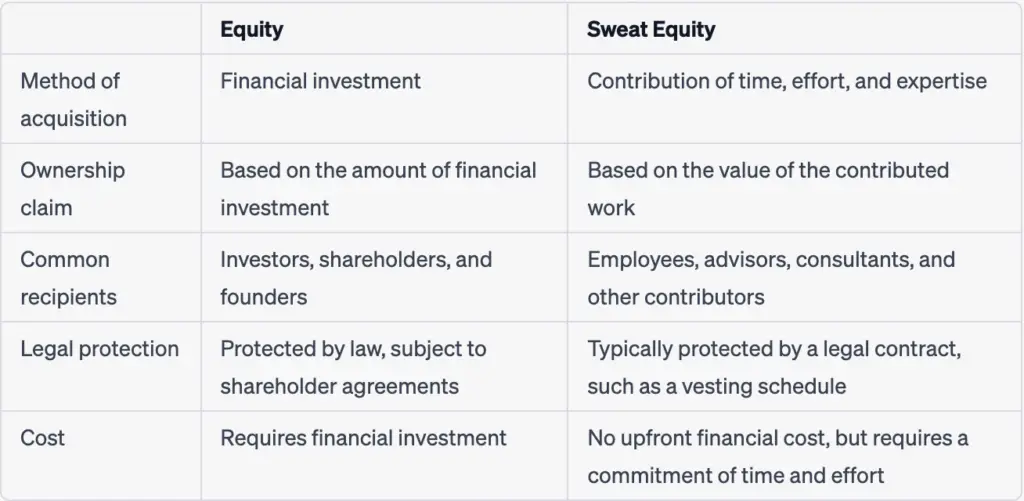Startup Sweat Equity: What It Is, Why It Matters, and How to Use It to Build Your Business
As an entrepreneur, starting a business is an exciting but challenging journey. You have an idea, a plan, and the passion to bring your vision to life. However, one significant challenge that many startups face is the lack of capital. This is where sweat equity comes in.
Sweat equity is a term used to describe the time and effort that an individual puts into a project or business in exchange for a share of the company. In other words, it’s working for equity instead of receiving payment in cash. Sweat equity is a popular concept in the startup world and has helped many businesses get off the ground. In this post, we will explore what startup sweat equity is, why it matters, and how you can use it to build your business.
What is Sweat Equity?
Sweat equity is the value that is created by an individual’s time, effort, and expertise. It is often used in the startup world as a way to compensate founders, early team members, and other contributors who cannot afford to invest capital into the business.
In essence, sweat equity is a form of investment. It is a way to obtain a share of the business in exchange for the work that you put in. This can include anything from developing a product or service, creating a marketing plan, or building a website. The value of the equity you receive is based on the amount of time and effort you put in, as well as the overall value of the business.
Results
If you’re not sure or you answer “no” to many of these questions, it might be worth taking some time to assess whether you have the right fit before moving forward.
#1. Do the founders have a deep understanding of the market and the problems that customers in that market face?
Why Does Sweat Equity Matter?
Sweat equity matters for a few reasons. First, it allows entrepreneurs to build their businesses without the need for significant financial investment. This is especially important for those who do not have access to capital or who are hesitant to take on debt. Sweat equity also allows startups to leverage the skills and expertise of their team members, without incurring the costs of hiring full-time employees.
Second, sweat equity aligns the interests of the team with the success of the business. When team members have a stake in the company, they are more motivated to work hard and achieve success. This can help create a strong team culture and increase the overall productivity of the business.
Third, sweat equity can be a valuable tool for attracting and retaining talent. When startups cannot afford to pay high salaries or provide benefits, offering equity can be an attractive alternative. This can help to build a team of passionate and committed individuals who are invested in the long-term success of the business.
How to Use Sweat Equity to Build Your Business
Now that we’ve covered what sweat equity is and why it matters let’s explore how you can use it to build your business.
- Identify Your Needs
The first step in using sweat equity to build your business is to identify your needs. What tasks or projects do you need help with? Where do you lack expertise? Do you need help with product development, marketing, sales, or something else?
Once you have identified your needs, you can begin to look for individuals who have the skills and expertise that you require.
- Determine the Value of the Equity
Once you have identified the individuals who will be contributing sweat equity to your business, you need to determine the value of the equity that they will receive. This can be challenging, as the value of equity is subjective and depends on a range of factors.
One approach is to determine the overall value of your business and allocate a percentage of that value to the sweat equity contributors. Another approach is to determine the hourly rate that you would pay for the work being done and multiply that by the number of hours contributed.
- Draft an Agreement
Once you have determined the value of the equity, you need to draft an agreement that outlines the terms of the sweat equity arrangement. This should include details such as the amount of equity that will be awarded, the scope of work that will be performed, and the timeline for completing the work. It should also include information about how the equity will be distributed and any vesting schedules that may be in place.
It’s important to have a lawyer review the agreement to ensure that it is legally sound and protects the interests of both parties.
- Monitor Progress
Once the sweat equity arrangement is in place, it’s important to monitor progress and ensure that the work is being completed according to the agreed-upon timeline and scope. This can be done through regular check-ins, progress reports, and milestone reviews.
- Vesting Schedules
Vesting schedules are used to ensure that sweat equity contributors remain committed to the business for a certain period of time. Vesting schedules typically involve a portion of the equity being awarded upfront, with the remaining equity being awarded over a set period of time.
For example, if a sweat equity contributor is awarded 10% of the equity in a business, they may receive 2% upfront, with the remaining 8% being awarded over a four-year period. This incentivizes the contributor to remain with the business and continue to contribute to its success.
- Communicate Clearly
Effective communication is crucial when it comes to sweat equity arrangements. It’s important to communicate the expectations, scope of work, and timeline clearly from the outset. This helps to avoid misunderstandings and ensures that everyone is on the same page.
It’s also important to communicate regularly throughout the sweat equity arrangement, providing updates on progress and any changes to the scope of work or timeline.
- Use Sweat Equity Wisely
While sweat equity can be a valuable tool for building a business, it’s important to use it wisely. Sweat equity should be used to fill gaps in expertise or to leverage the skills and experience of team members. It should not be used as a substitute for funding or to avoid paying employees.
How to set up a sweat equity agreement?
Setting up a sweat equity agreement involves establishing clear terms and conditions regarding the contribution of labor or services in exchange for equity in a project or business.
Here are some steps to help you create a sweat equity agreement:
- Define Roles and Responsibilities: Clearly outline the roles and responsibilities of each party involved in the agreement. Specify the nature of the services or labor to be provided by the sweat equity participant and the expected level of commitment.
- Determine Equity Distribution: Decide on the percentage or amount of equity that will be allocated to the sweat equity participant. This can be based on the perceived value of their contribution or through negotiations between the parties.
- Establish Vesting Schedule: If the sweat equity agreement involves a long-term commitment, consider implementing a vesting schedule. This means that the equity earned by the participant will be distributed over a specific period, typically subject to certain milestones or conditions. Vesting protects the interests of the business and ensures that the participant’s equity is earned gradually over time.
- Define Exit Strategy: It’s essential to address the possibility of the sweat equity participant leaving the project or business before the completion of their commitment. Determine how the equity will be handled in such situations, whether it will be retained by the participant or transferred back to the company.
- Include Terms and Conditions: Specify any additional terms and conditions relevant to the sweat equity agreement. This may include confidentiality clauses, non-compete agreements, dispute resolution mechanisms, or any other provisions that are important to the parties involved.
- Seek Legal Advice: Consult with a lawyer experienced in business and equity agreements to ensure that the sweat equity agreement is legally sound and enforceable. They can help you navigate the legal requirements, draft the agreement, and address any specific concerns or considerations related to your situation.
Remember, a well-drafted sweat equity agreement should be comprehensive, transparent, and fair to all parties involved.
It’s important to consult professionals and ensure that the agreement meets the specific needs and circumstances of your project or business.
How to calculate sweat equity?
The calculation of sweat equity can vary depending on the context, but here are a few common approaches:
- Hourly Rate: One method is to assign an hourly rate to the person’s labor or services and calculate the value based on the number of hours worked. The hourly rate can be determined by considering market rates for similar services or by mutual agreement among the parties involved.
- Market Value: Another approach is to determine the market value of the services provided by the individual. This can be done by researching the going rates for similar services in the industry or consulting with professionals to estimate the fair value of the work.
- Future Valuation: In the context of startups or early-stage businesses, sweat equity can be calculated based on the projected future value of the company. This approach often involves estimating the potential growth and success of the venture and determining the percentage of ownership or shares that the individual’s contribution would represent.
Difference between equity and sweat equity
Equity refers to ownership in a company. It can be acquired through investment, such as by purchasing shares of stock, or by being awarded shares of ownership in a company. Equity represents a claim on a portion of the company’s assets and profits.
Sweat equity, on the other hand, refers to the ownership stake earned by contributing time, effort, and expertise to a company rather than through financial investment. Sweat equity can be awarded to employees, advisors, consultants, or anyone else who contributes to the growth and success of a company.
Here’s a comparison table to illustrate the difference between equity and sweat equity:

In summary, while equity is acquired through financial investment, sweat equity is earned through the contribution of time, effort, and expertise to a company. Sweat equity can be awarded to employees, advisors, consultants, or anyone else who contributes to the growth and success of a company. Both equity and sweat equity represent ownership in a company, but they are acquired through different means and carry different legal protections.
Should you give sweat equity to mentors?
Mentors are often valuable resources for startups, providing guidance, advice, and access to networks and resources that can help the company succeed. Some mentors may be willing to offer their services in exchange for equity in the company, which can be an attractive option for startups that are short on cash but have a promising business model.
However, before offering sweat equity to a mentor, it’s important to consider the following:
- The value the mentor brings: Does the mentor have specific expertise or a valuable network that can help the company grow? If the mentor’s contributions are minimal or unclear, it may not be worth offering sweat equity.
- The nature of the relationship: Is the mentor playing an active role in the company, such as serving on the board of directors or providing regular advice and guidance? Or are they more of an occasional advisor who drops in from time to time? The nature of the mentor’s involvement can influence the decision to offer sweat equity.
- The terms of the agreement: If the decision is made to offer sweat equity to a mentor, it’s important to establish clear terms and expectations for their involvement and compensation. This can include a vesting schedule, a set number of hours per month or quarter, and a clearly defined role.
Should you give sweat equity to startup accelerators & incubators?
Startup accelerators are organizations that provide resources, mentorship, and funding to help startups grow and succeed. Some accelerators may offer their services in exchange for equity in the company, which can be an attractive option for startups that are short on cash but have a promising business model.
However, before offering sweat equity to a startup accelerator, it’s important to consider the following:
- The accelerator’s track record: Does the accelerator have a proven track record of helping startups succeed? Have they helped companies in similar industries or with similar business models? It’s important to thoroughly research the accelerator’s past performance before agreeing to give them equity.
- The services they provide: What specific services will the accelerator provide in exchange for equity? Will they offer mentorship, funding, or access to resources? It’s important to establish clear expectations and deliverables before entering into an agreement.
- The terms of the agreement: If the decision is made to offer sweat equity to a startup accelerator, it’s important to establish clear terms and expectations for their involvement and compensation. This can include a vesting schedule, a set amount of equity, and a clearly defined role.
Related Posts
Conclusion
In conclusion, sweat equity can be a valuable tool for startups looking to build their businesses without significant financial investment. It allows entrepreneurs to leverage the skills and expertise of their team members and aligns the interests of the team with the success of the business.
To use sweat equity effectively, startups need to identify their needs, determine the value of the equity, draft an agreement, monitor progress, use vesting schedules, communicate clearly, and use sweat equity wisely. With these steps in place, sweat equity can help startups to build strong teams, attract and retain talent, and achieve long-term success.
So, if you’re a startup looking for a way to build your business without breaking the bank, consider sweat equity as a valuable option. It may be just the tool you need to take your business to the next level.






















